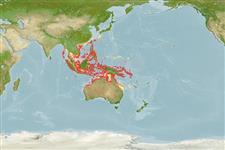Environment: milieu / climate zone / depth range / distribution range
Ecologie
marien rifbewoner; standvastig; diepte 3 - 40 m (Ref. 9710). Tropical; 32°N - 25°S, 92°E - 162°E
Indo-Pacific: Indonesia to Papua New Guinea, north to the Philippines, south to Rowley Shoals and the southern Great Barrier Reef; including Palau and Yap in Micronesia.
Grootte / Gewicht / Leeftijd
Maturity: Lm ? range ? - ? cm
Max length : 28.0 cm TL mannelijk / geslacht onbekend; (Ref. 9710); max. gerapporteerde leeftijd: 15 Jaren (Ref. 72479)
Dorsale stekels (totaal) : 13 - 14; Dorsale zachte stralen (totaal) : 17 - 18; Anale stekels: 3; Anale zachte stralen: 18.
Occurs in coral rich areas of clear lagoons, channels, and protected outer reef slopes. Changes to adult pattern is dramatic, and intermediate stage are rarely seen (Ref. 48636). Often solitary. Feeds on sponges and tunicates. Uncommon (Ref. 9710). Highly prized aquarium export (Ref. 37816).
Levenscyclus en paargedrag
Maturiteit | Voortplanting | Paaien | Eieren | Fecunditeit | Larven
Myers, R.F., 1991. Micronesian reef fishes. Second Ed. Coral Graphics, Barrigada, Guam. 298 p. (Ref. 1602)
Status op de Rode Lijst van het IUCN (Ref. 130435: Version 2024-1)
Gevaar voor de mens
Harmless
Gebruik door de mens
Visserij: visserij voor eigen gebruik; Aquarium: Commercieel
Tools
Speciale rapporten
Download XML
Internetbronnen
Estimates based on models
Preferred temperature (Ref.
123201): 26.1 - 28.9, mean 27.9 °C (based on 368 cells).
Fylogenetische diversiteitsindex (Ref.
82804): PD
50 = 0.5001 [Uniqueness, from 0.5 = low to 2.0 = high].
Bayesian length-weight: a=0.03236 (0.01318 - 0.07944), b=2.88 (2.70 - 3.06), in cm total length, based on LWR estimates for this Genus-body shape (Ref.
93245).
Trofisch niveau (Ref.
69278): 2.7 ±0.00 se; based on food items.
Weerstandsvermogen (Ref.
120179): Gemiddeld, minimale populatieverdubbelingstijd 1,4-4,4 jaar (Preliminary K or Fecundity.).
Fishing Vulnerability (Ref.
59153): Low vulnerability (18 of 100).
Nutrients (Ref.
124155): Calcium = 52.8 [27.0, 86.9] mg/100g; Iron = 0.557 [0.344, 0.909] mg/100g; Protein = 18.2 [17.0, 19.4] %; Omega3 = 0.097 [0.062, 0.153] g/100g; Selenium = 30 [17, 55] μg/100g; VitaminA = 69.3 [18.4, 250.1] μg/100g; Zinc = 1.4 [1.0, 2.0] mg/100g (wet weight);
